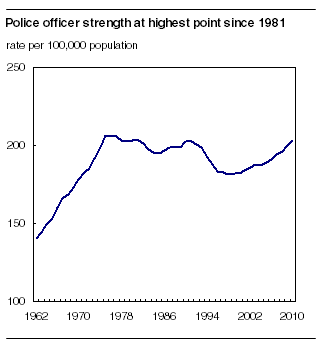Police personnel and expenditures
Archived Content
Information identified as archived is provided for reference, research or recordkeeping purposes. It is not subject to the Government of Canada Web Standards and has not been altered or updated since it was archived. Please "contact us" to request a format other than those available.
Related subjects
-
[an error occurred while processing this directive]
As of May 15 2010, there were about 69,300 police officers in Canada, up by almost 2,000 from 2009. Police strength, as measured by the rate of police officers per capita, increased 2% in 2010 to 203 officers for every 100,000 population, its highest point since 1981.

The largest increases in police officer strength were reported in Saskatchewan (+6%) and Alberta (+5%). Despite recent increases, Alberta reported the second-lowest rate, ahead of only Prince Edward Island.
As has been the case for the past decade, Saskatchewan reported the highest rate of police officer strength among the provinces, followed by Manitoba.
Among all census metropolitan areas, Saint John reported the highest rate in 2010, followed by Regina, Thunder Bay and Saskatoon. Kelowna and Moncton had the lowest rates.
As in previous years, the number of female police officers increased at a faster pace (+4%) than male officers (+3%) between 2009 and 2010. Females now represent about 1 in 5 officers, compared to approximately 1 in 15 in 1990.
While police officer strength increases, the volume and severity of police-reported crime is declining. In 2009, both the national police-reported crime rate and Crime Severity Index decreased, consistent with a trend observed over the past decade.
Saskatchewan and Manitoba, the provinces with the highest rate of police officer strength, also had the highest police-reported Crime Severity Index values.
The proportion of crimes solved by police, as indicated by the weighted clearance rate, rose for the fifth consecutive year in 2009. The national weighted clearance rate was 38.4% in 2009, its highest point since data were first available in 1998.
Among police services in areas with populations of more than 100,000 population, the highest weighted clearance rates were reported by Kingston Police and Durham Regional Police (Oshawa area), both at 48%.
Total spending on policing exceeded $12 billion in 2009. After adjusting for inflation, police expenditures rose by 7.3%, the largest annual increase since 1986 when data were first collected. This marks the 13th consecutive annual increase.
Note: An incident is considered cleared, or solved, by police if an accused person has been identified, whether that person is formally charged or dealt with by other means such as extrajudicial measures. To enhance the comparability of clearance rates among police services, a measure called the "weighted clearance rate" has been created. For both the Crime Severity Index and weighted clearance rate, each offence is given a weight based on the seriousness of that offence. For example, in the calculation of the weighted clearance rate, serious crimes solved by police count for more than the solving of less serious crimes.
Available on CANSIM: table 254-0002.
Definitions, data sources and methods: survey number 3301.
The report, Police Resources in Canada, 2010 (85-225-X, free), is now available. From the Key resource module of our website under Publications, choose All subjects, then Crime and Justice.
For more information, or to enquire about the concepts, methods or data quality of this release, contact Information and Client Services (toll-free 1-800-387-2231; 613-951-9023), Canadian Centre for Justice Statistics.
- Date modified:
